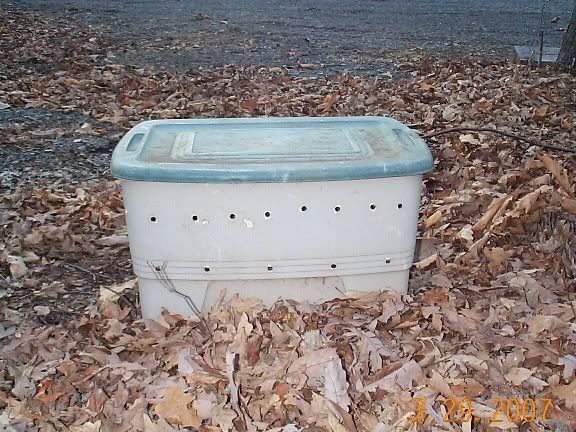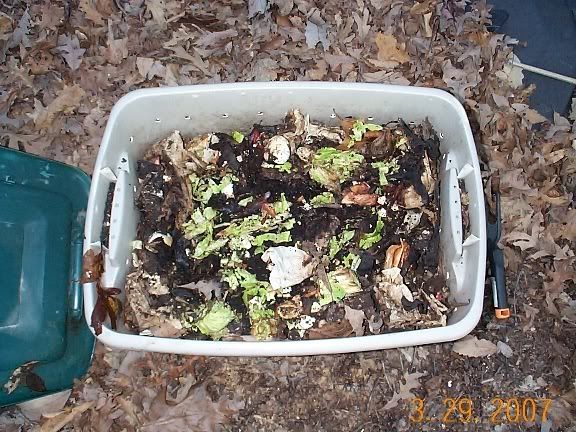Originally posted by davatsa:
catmandoo-
How did you establish your redworms? What works best to house them? Materials, size, etc. Do they eat some types of scraps better than others? I hope to dublicate what you're doing...it sounds like a lot of fun.
Worms are real easy to raise.
Worm House. My present bin came from Wal-Mart or K-Mart about 10 years ago. It cost about $7. As you can see in the photo, I drilled a series of half-inch holes around the outside. I also put about 5-10 holes in the bottom. These provide air and drainage. The worms are basically happy, and few decide to escape through the holes.
Establishing. I am about to completely clean out my present bin and start over. I do this a couple of times per year. When I do, I'll shred about five or six newspapers -- enough to fill 1/2 to 3/4 of the bin. Knowledgeable sources say to only use black and white, as the color inks can be poisonous. I have a small office shredder, but you could easily rip them by hand into small strips.
I will then put a couple of shovel fulls of garden dirt on top of the newspaper, and thoroughly soak it down with a hose. I'll let it drain for at least a day. Then I'll mix it all together.
Worms. In my case, I'll use my present worms -- more on that below. But, whenever I've had to start over, I just go to the local 7-11 or Wal-Mart and buy two or three containers of red wigglers. Around here, they typically package 30 to 36 in a container for $2-$3.
Adult worms, or "breeders" reproduce like crazy. In about a month, you will find many hundreds of small worms. They will grow fast, and turn into many many more hundreds -- plus the originals will keep breeding and getting even fatter. They'll grow to about half the size of a night crawler. If you start now, you'll be able to pick more worms than you can use by mid-June.
You can use most any kind of manure worm, but the red wigglers sold in bait stores have been bred just for this purpose. They are extremely hardy. Our bin has always been in a shady spot, and we've never lost ours to summer heat. Obviously they seem to know how to survive freezing too -- I just don't know how.
Food. We feed ours most of our vegetable and fruit scraps from the kitchen. This includes potato peels, banana peels, coffee grounds, tea bags, apple cores, old lettuce, etc. We give them all our egg shells. We DON'T give them any citrus (orange peels, grapefruit rind, etc), as the acid is supposedly harmful to them.
We have a mulch bucket that holds about a gallon of scraps. They get a bucket full once or twice a week. They make a bucketful completely unrecognizable in less than a week. I usually mix it into the top several inches.
Harvesting and Reconditioning. For fishing, you can obviously just go grab a handful when needed. But, they will need to be cleaned out now and then.
They hate light. An easy way to harvest lots of them is to get a board, a 5-gallon bucket, and a container for the worms. Put the board half-way over the bucket. Dig out a big scoop full of worms and castings from your worm bin. Put it on the board. Pile it like a pyramid. The worms will go down to get away from the light. Knock of the top and edges into the bucket. Pile it up again. Keep doing this until most of the dirt is in the bucket, and the board has most of the worms.
The "castings" make great fertilizer. Lots of excess worms make for great bluegill and catfish feedings.
Good luck.
Ken
P.S. Right after I posted this, I noticed there was another set of active postings with lots of good information about raising worms:
Raising European Night Crawlers 
